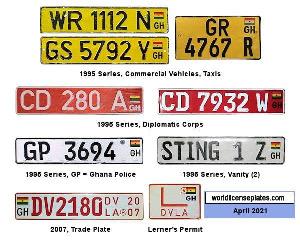In Ghana, you might have noticed some cars driving around with special number plates that begin with “DV.” These are not ordinary plates. “DV” is the acronym for Defective Vehicle, but don’t let the name scare you; it doesn’t mean the car is broken or bad. Instead, the letters DV are just the official name for a temporary license plate system introduced by Ghana’s Driver and Vehicle Licensing Authority (DVLA). The use of DV plates is governed by the Road Traffic Act, 2004 (Act 683), and the Road Traffic Regulations, 2012 (L. I. 2180), as well as policies set by the DVLA. The rationale behind issuing these special numbers to cars is to allow them to drive legally on our roads despite not completing the registration procedure. A DV plate is a short-term permit for a car.
The lifespan for a DV plate, according to the DVLA, is for a year from the day of first registration, after which the car must be fully registered. After that year is up, the car is supposed to get a permanent plate. During that year, however, the DV plate can move from one car to another if needed – for example, a dealer could take the plate off one car and put it on a different car. The plate always comes with a logbook where the driver writes down who is driving and where the car is going. This way, every trip is recorded. The law requires that the logbook be carried in the car whenever it’s using the DV plate, so officials can confirm the privilege is not abused.
Who uses DV plates, and why? The most popular group of individuals who use the DV plates are car dealerships, whose cars are not fully registered yet. Imagine a car just arrived from overseas at a Ghanaian port. Before it can get its regular plate, it ought to be driven from the port to a garage or testing station. For those first drives, the car needs a legal plate – that’s a perfect job for a DV plate. Similarly, think about a car dealership.
A dealer may have several new cars waiting to be sold, but they aren’t registered under new owner names yet. A DV plate lets the dealer move cars around, maybe a mechanic takes one out for testing, or a potential buyer takes a short test drive. The plate stays on only during those brief activities. This is why you often see DV plates on brand-new cars that are being shown or tested. DV plates are also handy after repairs or modifications. If someone’s car is in the shop for a big repair and isn’t registered for some reason, the mechanic might use a DV plate to drive it back and forth between workshops or to deliver it to the owner once it’s fixed. Any time a car isn’t ready for its permanent license but still needs to move on public roads for a day or two, a DV plate can cover it. Aside from car dealers, DV plates are also used by manufacturers, garages and freight companies. For example, vehicle manufacturers or dealers can acquire DV plates at DVLA offices.
These users typically have a trade license or permission to operate cars in that kind of business. There are some important rules, too. Because DV plates are only for specific uses, the cars shouldn’t be used for fun or transportation purposes. The law makes it clear that DV plates are not for taking your kids to school or friends to a picnic. A DV plate must be occupied by the owner only, but where it is on sale, it can be used by the seller, buyer and their mechanics only for purposes of testing. In other words, it’s fine for the car’s owner, a prospective buyer, or a mechanic to drive the car for work reasons, but not just for everyday family trips. That’s why every trip is logged in the book. If a police officer stops the car, they can check the logbook to see that the trip is legitimate. To see DV plates in real life, look around car yards and auto shops. A car dealer might have a clean new car with a DV plate as it waits for a customer; they can move it around freely for demonstrations or checks.




